The content of the article
The small gull is the smallest member of the gull family. In color, the small gull resembles a black-headed laughter or lake gull, although it is much smaller in size. The bird is very graceful and elegant, with beautiful plumage features, no matter what age. Most often, the gull of this subspecies can be found over shallow lakes and reservoirs, it easily flutters above the water and catches insects in a special way. What is more remarkable is a small gull, we will understand.
The appearance of a small gull
The body length of a small gull usually does not exceed 30 cm, the wingspan is 60-70 cm, and the weight is only 100 grams. The flight of the seagull is different from other birds - it flutters over the water, as it were, and does not fly straight ahead. This feature makes the small gull more like a swamp tern than a representative of gulls. A small bird in a wedding dress has a characteristic black color of the head in the form of a kind of hat. Dark eyes completely merge with the black color of plumage on the head, therefore they are almost invisible. The chest, sides, lower part of the neck and the undertail are white, sometimes with a pinkish tint on the peritoneum. The wings are gray. The beak is very thin and black, with red spots. The paws are also painted red, almost crimson. Young birds are very different from mature individuals - they do not have characteristic black and contrasting colors in the plumage, but there are many gray shades and numerous speckles.
Small gull habitat
Small gull feeding
The main diet of the small gull is insects and invertebrate animals. It can be dragonflies, bugs, locusts, mosquitoes, etc. The small gull prefers to catch insects on the fly - this is its corona way of obtaining food, like that of a swallow. In addition, the gull does not mind eating small fish, shellfish, various representatives of crustaceans. In search of food, a small gull flies low above the water and the coastal strip, and sometimes hunts on the shore above low vegetation. In search of crustaceans, the bird can go down to the shore and walk in shallow water. Seagulls of this species keep perfectly in the water, but do not dive into the water.
Features of reproduction and nesting of a small gull

The maturity of the small gull occurs in the third year of life.Birds nest in colonies, including not only the small but also the lake gull, as well as river and white-winged terns. Colonies on average are not very large in number - about 10-40 pairs of birds. Small gull monogamous - forms a pair for life. Mating games of young gulls are very interesting - the male curls around the female in the air, alternating between fast flights with short intervals of fluttering. On land, mating behavior is not as pronounced as that of other birds. In the air, the male often makes characteristic sounds, urging the female to form a pair. The small gull is trying to build nests in wet areas of the coastal zone. Most often these are water thickets in which a shelter is built from reed and other near-water plants. Rarely can a gull choose a small indentation on a rocky shore for nesting.
The small gull has a very characteristic cry, which allows you to accurately identify the bird among other members of the family. The sonorous voice of a small gull is heard as a long “kyok-kyok-kyek”. The proportion of small gulls in other gulls is about 8-10%. Due to the fact that small gulls often roam, rarely return to the same nesting sites, it is rather difficult to study birds, especially their migration routes. Scientists suggest that the total number of small gulls is about 10 thousand pairs of individuals. This includes all sedentary, nomadic and migratory gulls of this species.
Modern ornithologists note a widespread decline in the population of the small gull. This is facilitated by poor ecology, widespread drainage of water bodies, and poaching. To date, the small gull is not an endangered species, but is partially listed in the Red Books of some regions of Russia. In order not to lose the small gull, as a unique look, you need to make a maximum of protective measures for this.










Submit